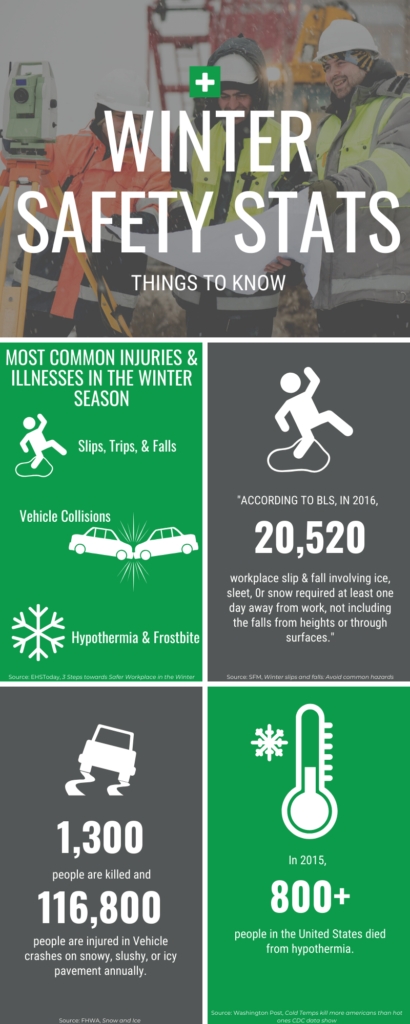Winter Safety Stats
Winter is upon us and tis’ the season for slick roads, wet floors, and miserably cold weather. Safety needs to be the top priority for workplaces affected by snow and sleet. Here are a few things to keep in mind when you are out and about this winter, whether it be in the workplace or on your time off.
Slips, Trips, & Falls
For starters, slips, trips, and falls are one of the most common injuries that happen in the workplace. And in the winter season, these incidents happen more frequently than ever. According to BLS, in 2016, “20,520 workplace slip & falls involving ice, sleet, or snow required at least one day away from work, not including the falls from heights or through surfaces.” These incidents happen very frequently. However, that doesn’t mean they should not be taken seriously. Injuries that can follow a slip, trip, or fall are;
- Bone fractures
- Contusions and bruises
- Severe abrasions and lacerations
- Sprains and strains (W.I.S)
Now in some cases, these accidents can, unfortunately, lead to a fatality. In 2018, 744 died due to these incidents (NSC). There are endless effects these three hazards have on workers’ lives, physically and non-physically, but how can these hazards be avoided in the winter season?
- First, use ice melt on any surface that ice can accumulate.
- Next, make sure there are “Caution slip hazard” cones are at every exit and areas where water is present. Also, putting a mat at the doorways can help not track in as much water.
- Another tip is to mandate slip-resistant shoes.
- Inspect PPE and equipment for any weather tampering or erosion.
- Finally, take the time to train all your employees on how to work in winter conditions.
Vehicle Collisions
Now, the next most common incident in the winter season is vehicle collisions. The Federal Highway Administration state, “Over 1,300 people are killed and more than 116,800 injuries due to snowy, slushy, and ice pavement every year. And near 900 people are killed and 76,000 are injured during snowfall or sleet.” (FHWA). Here are some tips to lower the chance of a vehicle collision:
- First, if you need to be out, driving carefully when it’s snowing or sleeting, and if the pavement is wet or icy is a no brainer.
- The next tip is to try to avoid residential areas or roads rarely used. There is a better chance that the main roads and highways have been properly treated with sand or salt.
- Also, if the need to drive is not pressing, don’t go out. If it can wait for another day, wait for the roads to be in better shape before you hop in the car or truck.
- Finally, take the time to train all your employees on how to work in winter conditions.
Hypothermia and Frostbite
Finally, hypothermia and frostbite are crazy important during the winter season. The CDC found too much cold has a worse effect on life than the heat has had. “In 2015, 800+ people died because of hypothermia, while less than 400 people died from hyperthermia” (WP). Now the ways to avoid hypothermia.
- First, watch the weather and if the need to be outside is not there, avoid that entirely.
- However, if you need to work outside, make sure to the employees are dressed appropriately and have the correct PPE for the weather.
- Another tip is to give multiple breaks for workers to have a hot beverage or be in a heated area.
- Finally, take the time to train all your employees on how to work in winter conditions.




